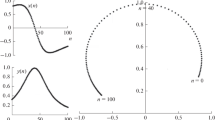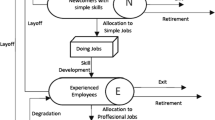Abstract
An approach to the dynamic optimization of the age structure of scientific personnel in an organization is presented. The appropriate mathematical model describing the age rotation of scientific workers is formulated and the criterion for maximizing the integral productivity of available scientific personnel over given time horizon is introduced. The criterion is constructed by using such scientometric instrument as the “curves of age productivity”. The practical application of suggested approach is demonstrated by means of real example.
Similar content being viewed by others
References
E. Bruckner, W. Ebeling, A. Sharnhorst, Application of evolution models in scientometrics,Scientometrics, 18 (1990) 21–41.
W. Shockley, On the statistics of individual variation of productivity in research laboratories,Proceedings of the Institute of Radio Engineers, 45, March 1957, pp. 279–290.
D. C. Pelz, F. M. Andrews,Scientists in Organizations. Productive Climates for Research and Development, New York-London-Sydney, 1966.
A. G. Butkovskiy,Distributed Control System, N. Y., American Elsevier, 1969.
Author information
Authors and Affiliations
Rights and permissions
About this article
Cite this article
Romanov, A.K., Terekhov, A.I. The mathematical modelling of the scientific personnel movement taking into account the productivity factor. Scientometrics 33, 221–231 (1995). https://doi.org/10.1007/BF02020570
Received:
Issue Date:
DOI: https://doi.org/10.1007/BF02020570




